Smart city success depends on data integration and system interoperability. In a smart city, myriad systems, from traffic lights and transportation to utilities and public safety – must seamlessly share information. When data is fragmented in silos, city managers struggle to get a complete picture, leading to reactive (not proactive) decisions. Conversely, a city that achieves smart city data integration can harness real-time insights across all departments, optimizing everything from congestion management to energy usage.
Studies confirm that data interoperability (the ability of different systems to exchange and use data in a standardized way) is crucial, ensuring diverse services work together efficiently to enhance urban living. In short, the flow of information between systems is the lifeblood of a truly “smart” city.
A connected smart city concept: a cityscape illuminated by network lines symbolizing data flowing through IoT sensors and systems. Integrating data across public infrastructure tech: traffic, utilities, safety, and more – allows the city to operate as a unified intelligent ecosystem.
The Need for Unified Data in Smart Cities
Smart cities generate massive amounts of data, from streetlights, traffic systems, public transport, utilities, to waste bins. But if each system runs separately on its own platform, cities are left with disconnected data silos. This fragmentation limits their ability to respond effectively to complex urban challenges.
For instance, traffic congestion solutions won’t work well if data from public transport, parking availability, or major events isn’t connected. Without integration, city leaders can’t see the full picture.
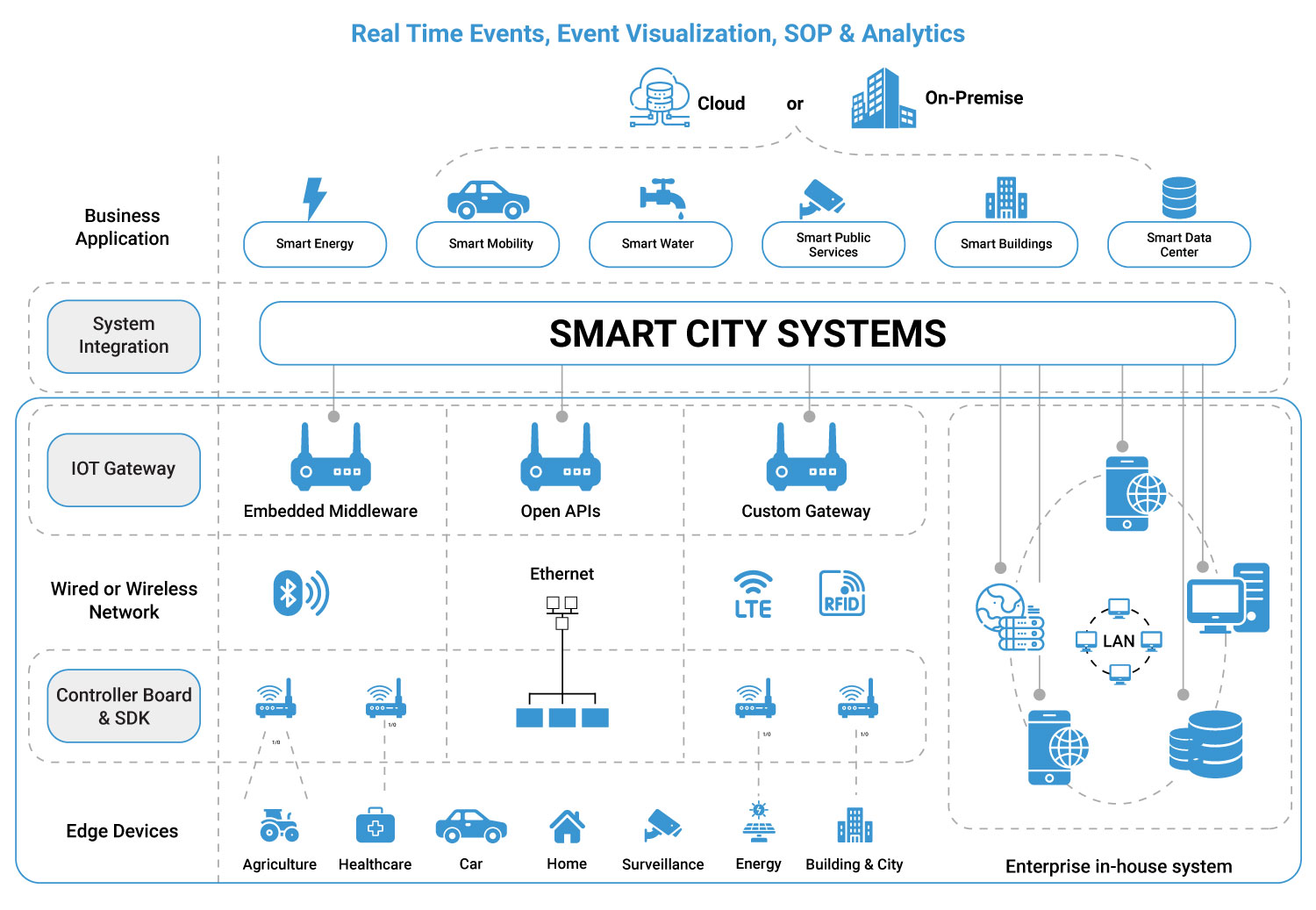
Unified middleware layer connecting smart energy, mobility, public services, and utilities via open APIs and IoT gateways (Source: trigyn)
That’s why a unified data infrastructure is essential. A centralized platform that aggregates and shares data across departments acts like the city’s digital brain, enabling cross-domain analysis and faster, smarter decision-making. With this in place, cities can:
- Dynamically reroute buses based on real-time traffic and transit data
- Prioritize emergency vehicles with integrated road and GPS information
- Improve energy efficiency by correlating consumption patterns across districts
Reports like the one from Interreg highlight that data integration directly supports better governance, sustainability, and citizen services. In this sense, unified data isn’t just a technical goal, it’s the foundation for delivering real public value.
Still, many cities struggle to achieve this vision due to legacy systems, incompatible data formats, and tech from multiple vendors that doesn’t work well together. As a result, smart city projects often remain isolated, smart lighting here, parking sensors there, but without meaningful collaboration.
To avoid this fragmentation, integration and interoperability must be a core part of smart city planning from day one. Only then can data truly drive the future of urban living.
Open Standards and Interoperability
To break down data silos, cities must prioritize open standards and interoperable systems. These are shared data formats and protocols that allow different technologies to work together, regardless of who built them. When cities adopt such standards, their sensors, software, and platforms can “speak the same language”, making it far easier to integrate new tools without costly rework.
A major issue in many smart city projects is vendor lock-in. When one provider’s proprietary system can’t interact with others, cities are forced to either stick with a single vendor or pay for expensive custom integrations. This not only drives up costs but limits future innovation and flexibility.
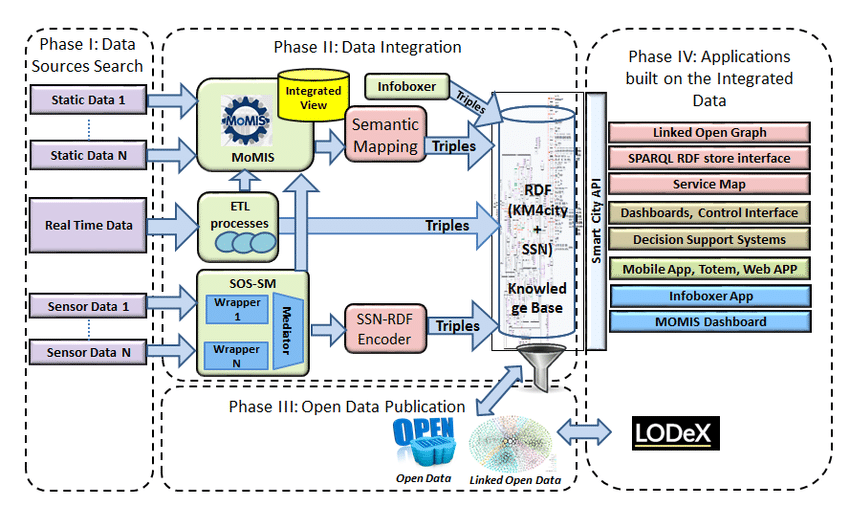
Core phases of smart city data value chain: integration, semantic mapping, open data, and application layer (ResearchGate)
To avoid this, cities should:
- Use open APIs that allow data and services to be accessed or shared securely
- Require interoperability as part of their procurement process
- Favor modular systems that can evolve over time rather than all-in-one, closed solutions
Countries like the UK have taken the lead. The PAS 180/181 standards from the British Standards Institution help guide how city systems should interconnect. Globally, initiatives like IEEE P2413 and ISO smart city standards offer frameworks to ensure different systems, even from different countries can integrate smoothly.
As one expert put it: “Open standards are essential for smart cities to scale. Without them, you can’t ensure sustainability or avoid vendor lock-in.”
However, technology alone isn’t enough. Organizational silos also hold cities back. Different departments or even public and private stakeholders, may hesitate to share data due to privacy, risk, or control concerns.
That’s why data governance is critical. Alongside technical standards, cities need:
- Clear data-sharing agreements
- Privacy and security frameworks
- Leadership that promotes cross-agency collaboration
Ultimately, a smart city isn’t just a city with more tech, it’s one where systems and people work together seamlessly. Achieving that requires both interoperability in design and trust in execution.
IoT Platforms and the Unified Data Layer
The Internet of Things (IoT) forms the backbone of smart cities. Thousands of sensors monitoring traffic, air quality, energy consumption, pedestrian flow and more, generate real-time data. But without a unified platform to collect and process this data, each device remains a siloed solution, limiting the city’s ability to act intelligently.
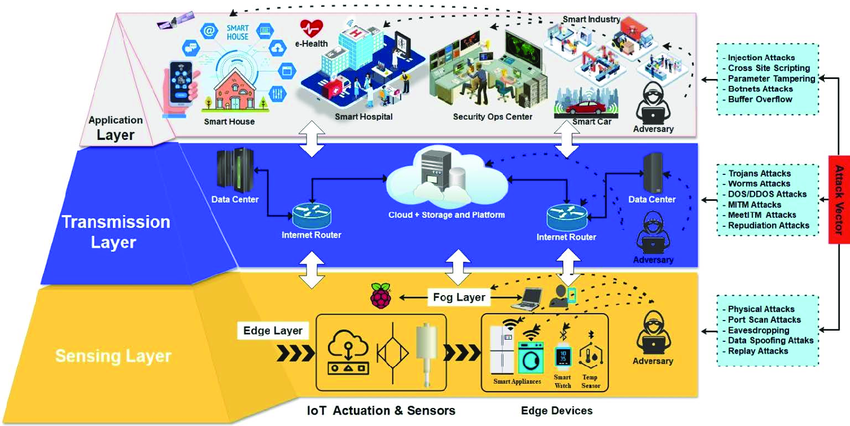
Smart city platform layers: edge, fog, cloud, and applications forming a unified data layer (Source: stagearcweb)
That’s where an IoT platform, or unified data layer, comes in. It acts as a central hub that ingests, standardizes, and distributes data from diverse sources. This enables cities to:
- Connect devices across different protocols
- Process and store real-time data at scale
- Share information via open APIs for various applications
When systems such as smart streetlights, traffic sensors, and environmental monitors feed into one platform, the city gains a cohesive view of what’s happening on the ground.
A unified data layer also enables advanced use cases, like predictive analytics and AI-driven automation. For instance, by combining live traffic camera feeds, public transit data, and weather forecasts, a city can dynamically reroute buses or emergency vehicles. In Malaysia, the proposed Smart City Data Integration Platform illustrates how a standardized approach to integration, prioritizing security, scalability, and interoperability, has become essential infrastructure, much like roads or power grids.
Open standards are critical at the IoT layer. Common protocols such as MQTT, CoAP, and HTTPS ensure that devices from different vendors can exchange data seamlessly. The EU-funded bIoTope project showcased how cities can use standards like O-MI and O-DF to integrate smart parking and waste systems across regions, proving that interoperability is no longer optional, it’s foundational.
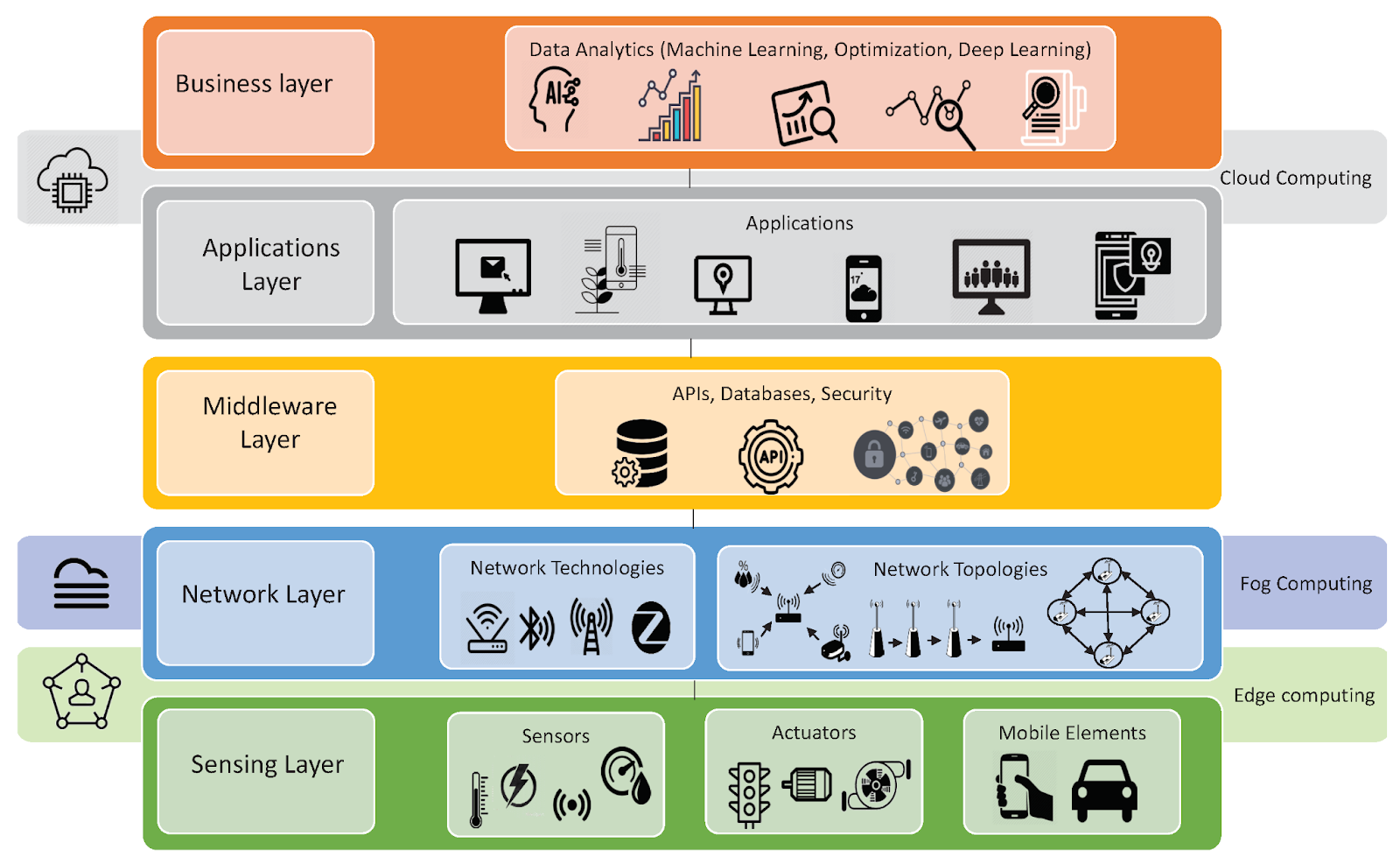
Stack including sensors, network, APIs and analytics, highlighting semantic interoperability (Source: MDPI)
The benefits of unified city intelligence include:
- Real-time dashboards for city officials
- Cross-departmental coordination and faster response times
- Future-proof infrastructure that can scale with new technologies
It’s not just city governments that benefit. Businesses and startups are also leveraging unified data layers to eliminate internal silos and boost operational efficiency. As Twendee Labs has seen, even automating manual workflows at the company level can unlock massive savings and smarter decision-making.
Whether it’s a business or an entire city, connecting data and systems leads to greater intelligence, agility, and impact.
Success Stories: Singapore, Dubai, and Beyond
Singapore
Leading smart cities around the globe have made interoperability a core principle – and their experiences offer valuable lessons. Take Singapore, often touted as one of the world’s smartest cities. Singapore’s government recognized early on that a fragmented approach wouldn’t scale, so they developed an Open Digital Platform (ODP) as part of their Smart Nation initiative. This platform is essentially a next-generation middleware or “smart city operating system” that supports cross-domain integration of all the city’s Operational Tech (OT) and IT systemsdeveloper.tech.gov.sg. The ODP connects diverse systems – building management, transportation, energy, etc. – into a cohesive whole, enabling real-time data sharing and coordination.
A key feature of Singapore’s approach is vendor neutrality and open standards: by adopting open architectures, they prevent vendor lock-in and ensure seamless integration with both existing and future systemsdeveloper.tech.gov.sg. In other words, any new solution deployed in Singapore must play nicely with the unified platform. This interoperability-focus has paid off: Singapore can implement citywide solutions (like its famous Virtual Singapore digital twin) much faster because the underlying data and systems are already aligned.
Dubai
Another shining example is Dubai. Dubai has aggressively pursued a smart city vision, and recently launched the Dubai Data & AI Platform as a unified data hub for the entire city. This platform is a gateway to all of Dubai’s official data and statistics, allowing government and private entities to host and exchange data seamlessly at high availability and security. It essentially provides a unified data layer for the city. Notably, the platform is built on an integrated “data fabric” and facilitates decentralized data exchange – it’s an evolution of Dubai’s earlier open data platform (Dubai Pulse) to an even more interconnected framework.
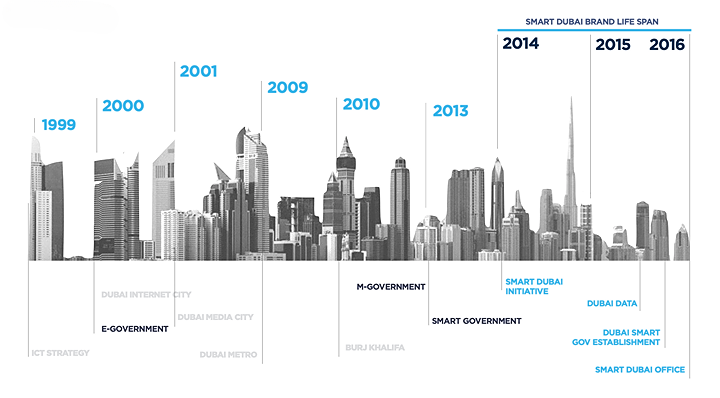
Dubai’s smart city journey: timeline of integration and platform development, highlighting a data‑centric transformation (internetsearchinc)
The initiative explicitly aims to meet government needs in data exchange, integration and interconnection across departments. By centralizing data with strong governance, Dubai is enhancing data-driven decision making and public service innovation. For example, city dashboards now aggregate data from traffic, police, utilities, and more, giving leaders a comprehensive view to respond proactively. Dubai’s leadership has emphasized that digital data is strategic national wealth, and that broad use of the data platform by government, businesses and even individuals will spur innovation and economic growth. The takeaway from Dubai: a citywide platform with open data sharing can transform a city’s digital maturity, but it requires top-level vision and cross-sector collaboration to implement.
Others
Other cities are following similar paths. European cities have been working on “urban data platforms” as part of initiatives like Interoperable Europe, developing requirements for open urban platforms that any city can adopt. South Korea’s smart cities (like Sejong’s smart city project) are building common data hubs from scratch to ensure everything integrates from day one. North American cities are collaborating via NIST’s smart cities framework to standardize how IoT data is shared for public safety, utilities, and transportation. In each case, the cities that are succeeding are those treating data integration and interoperability not as afterthoughts, but as central pillars of their strategy.
It’s also worth mentioning that interoperability extends beyond just technology, it includes policy interoperability between jurisdictions (sharing data regionally) and even inter-city interoperability (standards that allow applications developed in one city to be reused in another). The future might see smart cities sharing data seamlessly with neighboring cities (for example, for regional traffic management or disaster response). Achieving this will hinge on widely adopted open standards – painting a future where data flows not just within a city, but between cities, amplifying the benefits.
Conclusion
A truly smart city isn’t just about technology, it’s about integration. Without unified data and interoperable systems, even the most advanced solutions fall short. Cities like Singapore and Dubai thrive because they prioritize connectivity across all sectors.
Interoperability is not a cost, but a long-term investment in resilience, efficiency and innovation. From traffic and energy to healthcare and public safety, integrated systems unlock better decision-making, automation and quality of life.
At Twendee, we help governments and enterprises build scalable, secure, and connected digital ecosystems. From IoT integration to unified data platforms, our solutions are designed to break down silos and deliver lasting impact.
Let’s build smarter cities together.
Connect with us on LinkedIn or X to explore how Twendee can support your transformation: Twitter & LinkedIn Page
Read latest blog: Top 10 Emerging Markets for Web3 Startup Expansion in 2025





